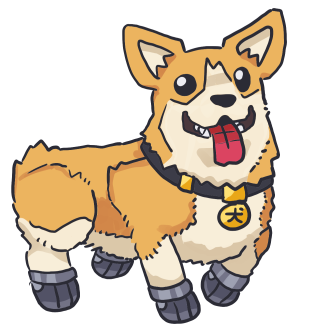
The Sol System is built out of many worlds, home to many people from many different backgrounds, and few places in the system are as great a melting pot of these worlds as Titan Garden, Saturn's domed little hub city. In this four-part series we'll look at the people who make up this bustling system- the Inner Belt, the Outer Belt, the Androids and the Extrasolars- and see what makes them tick.
The Inner Belt is the term used for the first four planets of the Sol System: Mercury, Venus, Terra and Mars, the four worlds that exist inside the Asteroid Belt. As many young starfarers recognize when they first journey off their homeworld, people from the Inner Belt worlds bear a striking resemblance to one another. Often shivering cold with thick pelts on their heads, if you ever encounter a humanoid on your journeys they are definitely from one of these four worlds. No one is certain if it was convergent or divergent evolution that produced them, but the Asteroid Belt has clearly contained them within the warmer band of the system. Despite looking similar to each other, their four worlds have an extreme variety of climates and have produced four wildly different sets of adaptive characteristics. Wherever they travel, starfarers from the Inner Belt make good use of their unique adaptations in whatever work they pursue.
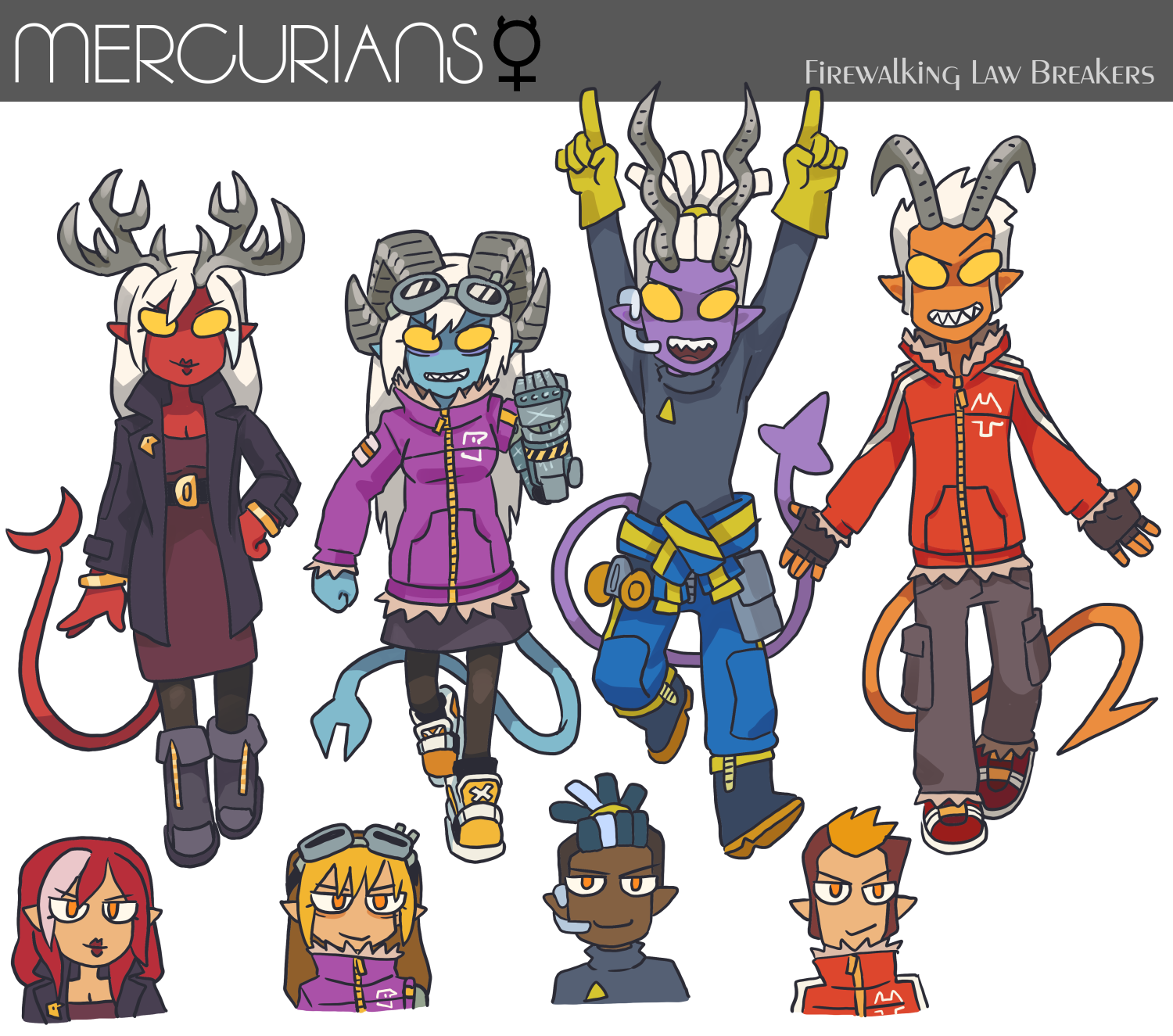
"They say trouble always seems to follow the people of Mercury, but I'll tell you what, I'd rather have a Mercurian as an ally than an enemy. That's for damn sure." -- Big Henry, outworld frontiersman
Homeworld
Mercurians hail from a blistering hot, irradiated, zippy little planet, and as such they tend to be the weirdest of the Inner Belt humanoids. Did you know Mercury has polar ice caps? Shaded by the rim of a large crater, these ice caps are where Mercury's major cities are, connected by an underground network of tunnels and cavernous little pocket towns. There are a few habitable structures on the surface, but they're usually connected to the underground network by a couple tunnels- Mercurians generally require using a specific set of unique adaptations in order to safely inhabit these surface buildings. There is a rich ecosystem of plants and wildlife beneath the surface of Mercury, and Mercurian cuisine tends to be meaty, high in calories and very, very spicy. Many Mercurians like to wear a special kind of leggings or undershirt that helps them adapt to moving between extreme heat and the chilly ice of their cities- woven from plantlife endemic to the sun-scorched surface of their world, these garments can be spotted by their dark brown color and thick mesh, and are fairly popular among other cold-intolerant species.
Appearance
Mercurians are easy to tell apart from their Inner Belt neighbors. All Mercurians develop a sunstreak in their hair, a patch of lighter hair in some spot or another. They have pointed ears and sharp canines, and most strikingly of all, they all have ember-colored eyes; irises that glow a soft, luminous orange like the scattered remnants of an exhausted campfire.
Characteristics
Living beneath the surface of a hot, dry planet, Mercurians have a couple minor adaptations and one extremely large talent.
- A Mercurian's natural lifespan is about 150 Terran years, although particularly reckless Mercurians will go out in a grand spectacle before they reach that point.
- Their ember eyes give Mercurians excellent low-light vision, allowing them to navigate their underground tunnels with ease.
- Having a higher-than-average internal body temperature makes Mercurians highly resistant to virus, bacteria and parasitic infections native to planets colder than their own.
- Mercurians are born with a small mark on their lower back, usually a simple shape of some sort.
- Every Mercurian is born with a Gift of Sol, an innate talent which defies explanation, so let's go ahead and explain it in more detail.
Gifts of Sol
One of the most notable qualities of a Mercurian is their seemingly-unnatural affinity for some aspect of the universe or another. No one can explain why they manifest these abilities but the leading theory is generations spent in extremely close proximity to an enormous glowing fusion reaction has affected their eyes in a way that, really just can't be explained. A Gift of Sol manifests as an ability to perceive some abstract concept, reading it and comprehending it in a way that exceeds scientific measurement, in a way that is perfectly natural to them. These abstract concepts are typically very specific and can vary broadly- two Mercurians can inherit the same Gift and interpret it in their own ways, but some rare few Mercurians inherit extremely potent Gifts and go on to live short, explosive lives and become the stuff of legends.
Firewalker Form
The capstone of their characteristics, Mercurians are able to assume a form that greatly enhances their natural abilities and makes them extremely resistant to heat and radiation, allowing them to thrive in environments that would otherwise extinguish all other forms of life, in particular the naked surface of their own planet Mercury. Activating in a flash of heat, Firewalker Form causes a Mercurian to take on a chromatic hue, their hair turning a heat-repelling white. Their eyes turn from warm embers to a bright gold, and they inexplicably develop a set of horns on their head that tends to reflect the nature of their personality. The mark on their lower back extends out into an impish tail, its tip bearing a sharp shape that reflects the nature of their Gift.
While in Firewalker Form a Mercurian can go beyond just perceiving their Solar Gift, they can alter them in ways that are scientifically impossible. Believed to be an extension of the Mercurian's will, the effects of their law-breaking only last as long as they are in Firewalker Form, and their subjects will revert to their normal state once the Mercurian returns to normal. For some illustrative examples:
- Scarlet's purview is Value, and so in Firewalker Form she can alter a forgery's inherent value to pass it off as genuine art, twist the values of a buyer to align with something she has or reduce the value of her companions in connection to pursuing law enforcement.
- Amy's purview is Machinery, so she can will a broken construct to continue working beyond its ability to do so, alter what function she believes that machine should perform or rearrange the configuration of a machine's component parts in a way she desires. While in Firewalker Form Amy can feel tactile sensation in her prosthetic left arm, which she otherwise cannot.
- Marcel's purview is Gravity, allowing him to alter the mass of objects- enough to lift a starship by hand or make a marble immovable, change the direction of a body's gravitational pull- enabling him or others to walk up walls or on ceilings- or create new gravity wells entirely- permitting others to walk on deep space structures without any active gravity wells at all.
- Jack's purview is Trajectory & Velocity, which he can use to bend light from his starship's laser cannons in impossible ways, to hit impossible shots on a pool table, to swerve blaster fire directed at him in another direction and to "airstrafe" when he leaps into the air.
One of the major limiting factors in Mercurians using Firewalker Form to ply their tricks is they have to maintain this form for the effects to stick, so it's always very obvious when they're up to something. They can be clever about subterfuge but they're not generally inclined towards subtlety.
Maintaining Firewalker Form is a delicate balancing act. While in this form a Mercurian's personality tends to exaggerate a bit, which can be grating to non-Mercurian friends. They also burn a lot of calories in Firewalker Form, which is the basis of their spicy, high-calorie diets. If they get too hungry they will fall out of the form and return to normal. Red Stuff is a popular bottled herbal drink, topping up their energy and allowing them to maintain Firewalker Form for extended periods. On a full stomach they can maintain their form for about three hours, but the more they use their gifts to bend reality the more calories they'll burn and the hungrier they'll get.
Despite having a relatively long natural lifespan, Firewalker Form is the leading cause of death among Mercurians. They all gladly take full advantage of their gifts; go big, go bright, go out blazing.
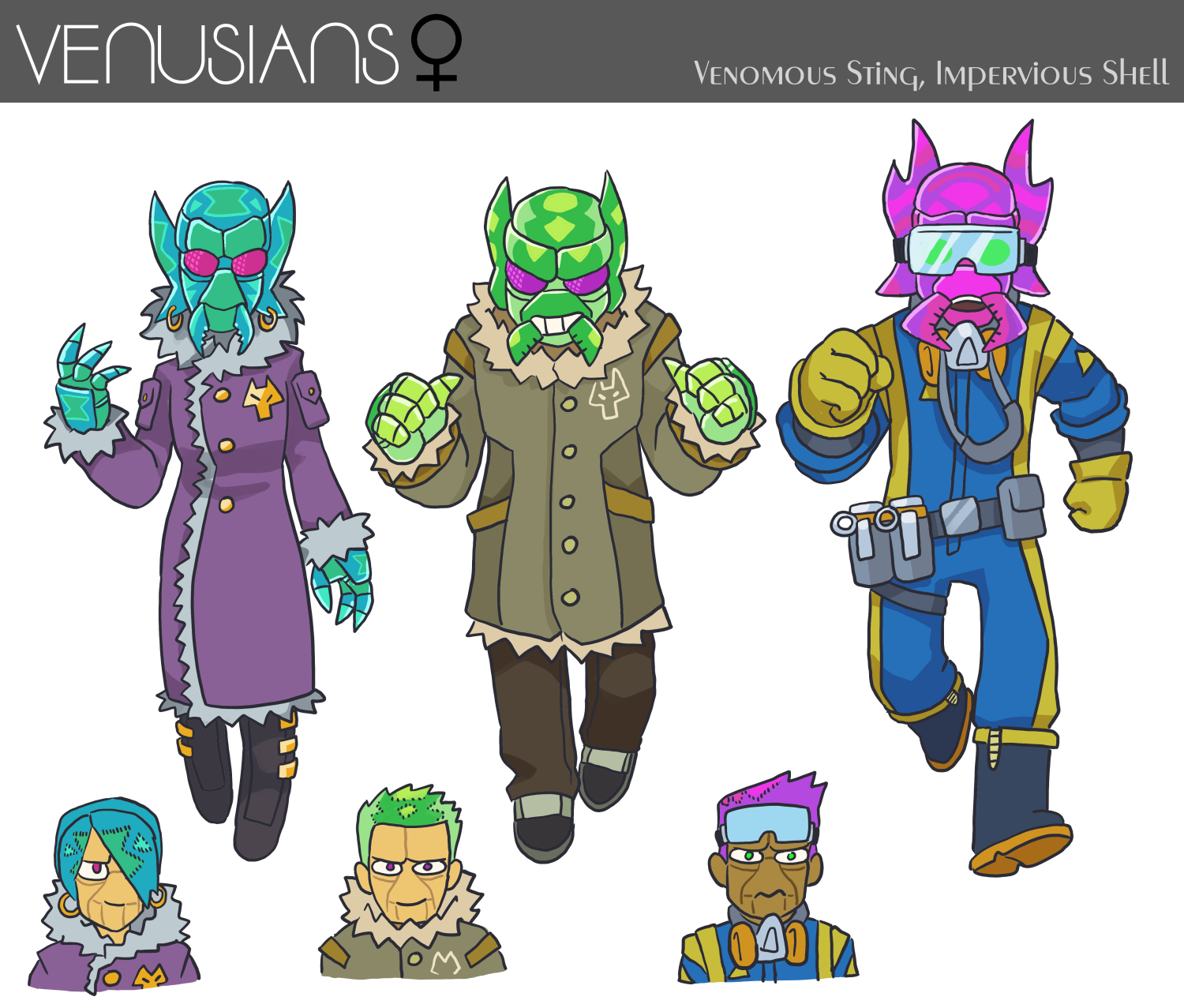
"Awh, don't let 'em fool you. Some of the sweetest people I've met are Venusians. Some of the meanest are too, I guess. Books and covers, man, that's all I'm saying." -- Puke Commander, lead singer of scuzcore band "The Pukes"
Homeworld
Venus is a harsh world blotted by thick clouds and pelted with searing acid rain and cracks of lightning, but it is also inexplicably host to a wide range of lifeforms who thrive in this hostile environment. Venusian plant life grows waxy and indelicate, bearing many bright colors influenced by the acidic rainfall, and Venusian livestock is among the hardiest in the system. Major Venusian cities are few and far between, with smaller townships existing beneath the thick canopies of Venusian forests, giving the planet a very rural aesthetic. Venusian fashion tends to favor wide-brim hats and layered mantles designed to keep the acid rain off as much as possible.
Appearance
Venusians are very distinct from their neighbors in the Inner Belt. Most notably, their skin grows in thick callus-like plates, their interconnecting edges appearing as seams or lines across their body. Their eyes take on bright, fruit-like colors. Venusian hair grows in similarly bright colors, but never as one solid hue, it always grows with an insect-like pattern of shapes and colors unique to each individual. They also have either never evolved or simply evolved away the need for a fifth little finger, having distinct four-fingered hands without any little slackers on the roster.
Characteristics
Life beneath the stinging rainfall has gifted the people of Venus with a number of unique physical traits.
- A Venusian's lifespan is about 120 Terran years, although they tend to die of old age more often than their neighbors closer to Sol.
- Venusian bodies are highly regenerative, allowing them to heal even severe wounds or missing limbs with time.
- Venusians have venom glands in their mouths, allowing them to secrete a strong paralytic agent that can temporarily immobilize an organic lifeform. Venusian medicine offers an antivenom freely to all other species.
- Each Venusian is able to grow a thick carapace from their skin plates. More on this below.
Carapace Form
Like Mercurians, Venusians also have a transformative state they can assume to help survive in their native environment. Carapace Form hardens the dermal plates of a Venusian's skin into a thick, extremely tough shell around them, adding an extra layer of protection to their regenerative but softer core, with a particularly high resistance to corrosion and electrical damage. These plates take on the color of their hair, and the pattern found in their hair is reflected in the patterns that form on their shell throughout their body. In addition to simply hardening around their skin, Venusians gain a protective layer over their eyes matching the color of their irises. Their fingers harden into sharp clawed tips, and their ear cartilage grows out into distinct shapes, forming into a sort of crest around their head.
Perhaps the most notable trait of Carapace Form is the development of pincer-like mandibles growing from the articulated plates at the corners of their mouths. These mandibles can be controlled independent of their normal jaw movement, pinching side to side on their own. They can take on different shapes unique to each Venusian, being either smooth or serrated, but one thing they all have in common is they are all an efficient means of delivering their paralytic venom. A victim of a Venusian bite will feel numb after a few moments and eventually collapse- it's a nonlethal venom, but Venusians have ways of fixing that if they need to.
Molting
The major limitation of Carapace Form is that it can't be turned on and off easily. While a Venusian doesn't have the calorie limitations of a Mercurian, once they harden their skin into a carapace they are stuck with that form until they molt out of it. The carapace can take a lot of nicks and cuts and cracks and burns, and all the damage it accumulates can simply be shrugged off with a good molting, but the Venusian has to wear that somewhat scary facade until they can find a moment to slip out of it. It's a pretty gross spectacle, they have to "crack their back", curling forward to split open the back of their carapace, and then pull themselves out of it like they're taking off a full-body suit. The problem of how to dispose of a Venusian carapace is a tricky one, but they are biodegradable and intrepid Venusians have found clever ways to recycle them into other products. A good shower afterwards is recommended, as a molted Venusian can be pretty goopy for a bit.
Be sure to remove any piercings or other jewelry from your carapace before disposing of it! You'll be cussing and kicking yourself when you're looking for your favorite gold earrings and you remember they're in the crest of your last molt. Happens to the best of 'em.
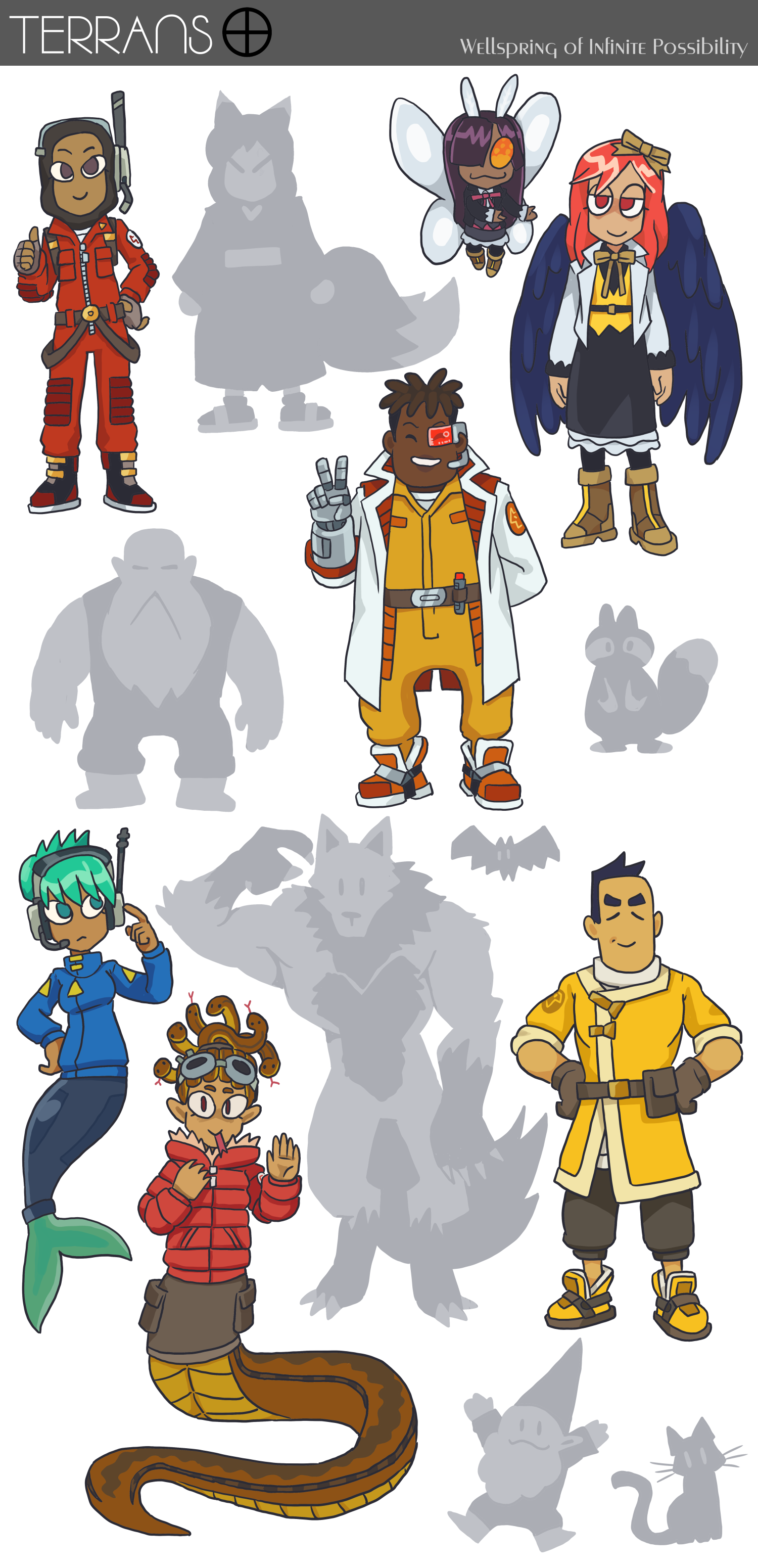
"Oh, it's easy! If you've never seen anyone like them on your way there, no one else when you get there and you never see anyone like 'em on your way home, that was most probably a Terran. Works every time!" -- Chip, abandoned station explorer & vlogger
Homeworld
As you may well know, Terra is the most bountiful and abundant planet in the entire Sol system. Boasting a climate that is pleasant to people from all worlds, Terra is very carefully maintained by its people as a jewel of the galaxy. Water, clean and soothing; the air crisp; the seasons a rolling gallery of aesthetics. Terra is a world teeming with life of all kinds, rich with resources and temperate in its atmosphere, it's no wonder so many cities have risen and so much culture has formed on this one azure little rock.
Appearance & Characteristics
Terra being the bountiful planet that it is, it's hard for anyone to pin down what a sentient Terran "looks like" as there's just so many different kinds of Terrans. Sometimes called a grab bag of humanoids, Terra has an infinite capacity to produce permutations of the human form. Some notable examples to illustrate the point:
- Mahnoor, Clayton and Dr. Lin represent the baseline idea of a Terran, looking like their planetary neighbors but without the dramatic adaptations to their homeworlds.
- Kotori, a winged woman with a bioluminous glow; and Fremble, a moth-like Terran with a strong affinity for Kotori's lampness.
- Carol, an amphibious Terran who can breathe water as easily as air. Her lower body is adapted for hydrodynamic propulsion, making her an extremely good swimmer.
- Lydia, a fork-tongued Terran who appears as much a humanoid as a nest of snakes, using her lower body to glide smoothly on the ground and enjoying the benefit of a distributed network of brains to help compartmentalize her thoughts.
- Some Terrans hailing from mountainous regions have been known to be short and strongly-built, with great pelts growing from their faces.
- Other sentients take on the appearance of baseline Terrans as a ruse, existing as one of a few kinds of endemic wildlife.
- Still other Terrans will take on the reverse effect, growing as large as a Callistan and growing their pelt all over, assuming the form of endemic wildlife when exposed to Sol's light reflected off moonrock. Very strange.
- Terrans have been documented who only exist outside the light of Sol, who feed off blood and, again, take the form of wildlife.
- Yet another line of Terrans have learned to draw from an arcane energy within their planet, part of its gift of boundless life, and alter the world around them through their will and sorcery, occasionally using this power to assume the guise of, well, you get the idea.
- They're not all connected to wildlife. Some rare few Terrans are horrid little guys with conical caps who have an endless, grating energy about them. There's a few of them on Titan, in fact, so watch your step.
This is not an exhaustive list. There are many shapes and types of Terrans, with many adaptations to the many environments of their world. You're bound to meet any sort of humanoid on your journeys, and if you don't recognize where they're from, they're probably Terran. There is also just a large number of Terrans in general. There are probably more Terrans than there are Mercurians, Venusians and Martians combined, so it's worth keeping those numbers in perspective.
On average, with some extreme exceptions, the average lifespan of a Terran is about 80 years. There's a lot of them but there's a higher turnover rate compared to their neighbors.
The Curse of Arrogance
Terrans have it pretty good compared to most other worlds. It's a beautiful place and most Terrans take a degree of pride in keeping it beautiful, but this boundless comfort can make them a bit arrogant when they venture out into the Sol system and meet their neighbor species. Terrans tend to regard their world as the "default" world in the system, comparing other planets to theirs and sometimes pondering how they can Terraform a world to bring it more in line with Terran ideals. This idea has been pitched in the past, leading to an attempt to build Garden-style colonies on Mercury and Venus with the intent of helping steer their climates in directions that are more pleasant to other species, namely Terrans. This attempt was thwarted by what would later become a notorious band of space pirates and remains a bit of a welt on the name of Terra, and an almost mythical legend for Mercuy and Venus, but such is the Curse of Arrogance. If our world is perfect, wouldn't you want a perfect world too? We can make that happen.
Terrans do learn to unlearn this Curse, but sometimes their presumptions creep up on them when they travel off-world. There is a prevalent myth among Terrans that the other Inner Belt humanoids are offshoots of their lineage, rather than convergent evolutions of unique origins, and that can really chafe some of the other species. There's no concrete basis for believing everyone else are just offshoots of Terra but occasionally you'll get some young Terran starfarer chatting up a space bar and they get the sharp idea to drop this bit of trivia into the discussion. At least one has found their way out of the bar through its front window, courtesy of the Curse of Arrogance.
Technology
With Terras own natural resources comes a wellspring of technology. Every starfaring world produces its own technological advancements but with Terra that output is tenfold most other worlds. Most of the Sol system's licensed manufacturers of sentient Androids- United Robotics, Delta Astronautics, Accra Systems and Aoba Laboratories- are all from Terra, for example. Terran cybernetics are also a rapidly-growing field, offering sleek enhancements or articulate prosthetics to those with needs or wants that extend beyond the limits of the flesh. Terrans don't typically have any outstanding, common characteristics, but a few metal bits and bobs can put a Terran on even footing with the tricks and traits of their neighbors.
Thanks to its gift of resource Terra is one of the two planets in the system to boast a whole fleet of starfaring battleships, alongside Neptune in the Outer Belt, who tend to take it upon themselves to keep their idea of peace in their respective regions of space. Terran technology, along with Neptune's, helped build Titan Garden from the foothold of Mars's Titan Station, and it is an engineering wonder that has bridged the inner and outer worlds of Sol. This technology can be used for the good of all people, but it must always be tempered against Terra's Curse of Arrogance, lest the likes of the Devil's Fang pirates take a bite out of their plans. It's happened once before, and a memorable lesson has definitely been learned from the affair, but in true Terran fashion that black eye hasn't been forgotten.
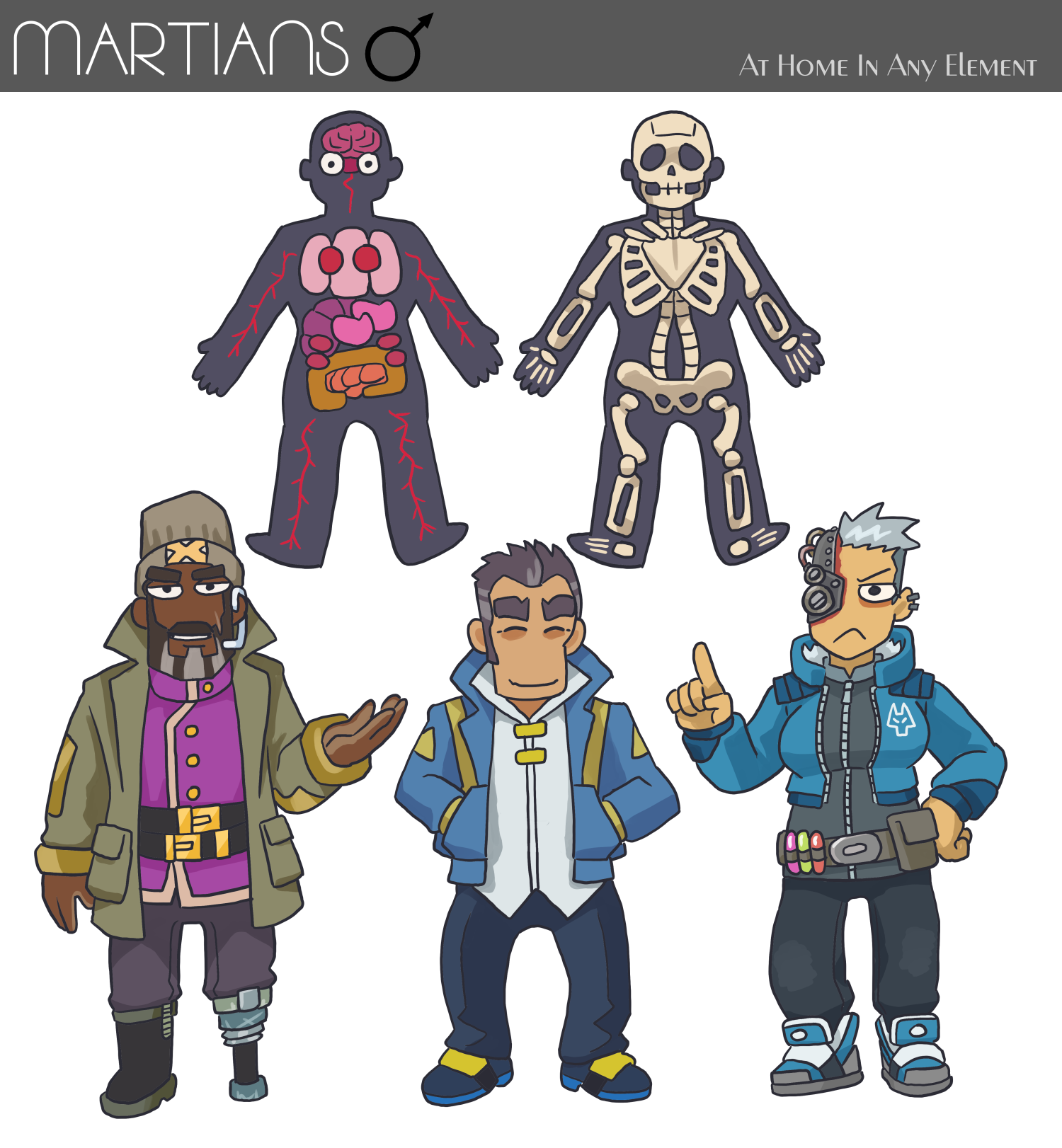
"Why's it always every world you visit, they always got old, old stories of Martian invaders from outer space? Well, that's the thing with Martians. There's nowhere they can't go. It's remarkable."
-- Savannah, xenocritter rancher.
Homeworld
Mars is an arid, dusty planet. Sparse with resources, Mars is a far cry from the buffet of comforts their next-nearest neighbor enjoys. Moisture is drawn out of the soil through clanking, noisy machines and the creatures who roam the surface are tough and difficult to eat. Early Terrans often fantasized about living on Mars, but were rebuked by their friends, pointing out how it'd be impossible to live on a planet with nothing to eat or drink, you'd die up there! The truth turns out to be six of one, half a dozen of the other, but life on Mars is anything other than a fantasy.
Appearance
Martians are the most nondescript of the Inner Belt humanoids. Occasionally mistaken for Terrans, Martians' two major external distinctions are their eyes and their frames. Martian eyes have coal black irises, like the cold ash opposite the campfire embers of a Mercurian. They also have broad, stocky frames that house the secret to their remarkable survivability, their bones and their organs.
Characteristics
Martians don't wear their adaptive qualities on the outside. Rather, a Martian's internal organs are the secret to their ability to live on a planet with few resources and survive the trials of early starship travel to distant worlds in an age before the warp drive. Compared to their Inner Belt neighbors, a Martian's physiology includes:
- An adaptive nervous system that can consciously subdue pain receptor signals.
- Protected optic lenses that can darken to filter extreme bright light.
- A second heart to share the workload of pumping blood under stress.
- A third lung which enables them to filter essential elements out of toxic or polluted air.
- Two stomachs, allowing them to process and digest spoiled, tough or nearly-inedible food.
- Four kidneys, to purify toxins in their bloodstream more effectively.
- A segmented liver capable of handling four different filtration jobs at once.
- A reinforced plate at the top of their skull where others have a fused seam.
- A second set of clavicles reinforced by a large sternal plate, protecting their hearts and lungs.
- Tandem spines that diverge at the lower back, creating a stronger reinforced triangle shape.
It's a laundry list of features, but it's what enables Martians to exist almost anywhere they see fit to go and allowed them to be some of the Sol system's earliest starfarers. They're not as flashy as Mercurians or as protective as Venusians, but a sturdy Martian will always find a way to get the job done.
Martians are the longest-lived of the Inner Belt humanoids, having an average lifespan of 200 Terran years, with some living much longer through extremely disciplined self control.
System Control
The Martian body is loaded with an array of tools to help them adapt and survive, but the key to making them all work is the Martian's ability to voluntarily control involuntary body systems. It basically works like a slider, where a Martian can slow down their metabolic processes, slow their breathing and their heartrate and enter a low-power mode, allowing them to live and function for a very long time on very limited food, water or sleep, albeit at a reduced level of power. Conversely, they can ramp up their body systems to gain a boost in physical performance with enough redundant organs to offset an increased onset of fatigue. Grizzly John made a name for himself piloting the Grand Elk on extremely long cargo voyages without overloading his ship with perishable foods thanks to a low system setting, and Emily managed to cleave her ex-girlfriend's arm off at the shoulder with a wave cutter despite having half her face blasted off the side of her head thanks to a very high system setting. Whatever normal situation arises, a Martian can adapt to it.
Prosthetics & Cybernetic Modification
One of the novel perks of the Martian constitution is it gives them a remarkably high tolerance for body modification and prosthetics. While some might describe it as "clunky", Martian tech is simple and robust, getting the job done without undue complications. Martians have been grafting metal bits to their bodies a century before anyone else was putting ships into space. Big plates, big hoses and big camera lenses are the trademark of a Martian cybernetics job, and whatever the situation they're generally able to bolt something together and get themselves back off the ground. Martians are even able to take a special kind of bioluminous ink in the form of tattoos that can be made to glow with a bit of circulatory pressure.
The apex of the Martian prosthetic job was the development of the CX Unit, the system's earliest androids. What were essentially big prosthetic bodies with rudimentary life support systems were able to house and sustain a Martian brain and nervous system on its own for a century or more. While some may point out that the practice did ultimately result in a system-wide ban on putting organic brains into synthetic bodies, a Martian might take pride in knowing only they were able to push the envelope that far in the first place.
Mining
As mentioned, Martians were among the first to take to the stars and travel to distant worlds, so legends of Martian Invaders exist in many species' fiction. Martian progress was never intended to take over another species' home world, they initially took to the stars in search of finding more mineral resources to improve their conditions on Mars. Early Martian ships traveled from Mars to the nearby Asteroid Belt, setting up manned mining operations in order to extract the minerals they needed to build their civilization at home. Mars has vast stretches of arid desert but its concentrated cities are very hospitable to people from all over, drawing plentiful water up from deep wells and even growing lush plants in contained arboretums. It's thanks to the extra resources extracted from the Asteroid Belt that Martians were able to build such remarkable cities up from so little.
It was this off-world mining experience which allowed Mars to spearhead the Titan Project, building Titan Station as a habitable structure on Saturn's moon, making the way for Terran and Neptunian technology to build Titan Garden. The station has since become a bustling hub for people from all worlds to come together and chase their dreams. A fair number of those people come from the Inner Belt worlds, and while they may look similar on the surface, they all come from unique worlds with starkly-different background and bring their own remarkable talents and adaptations with them on their journeys.


